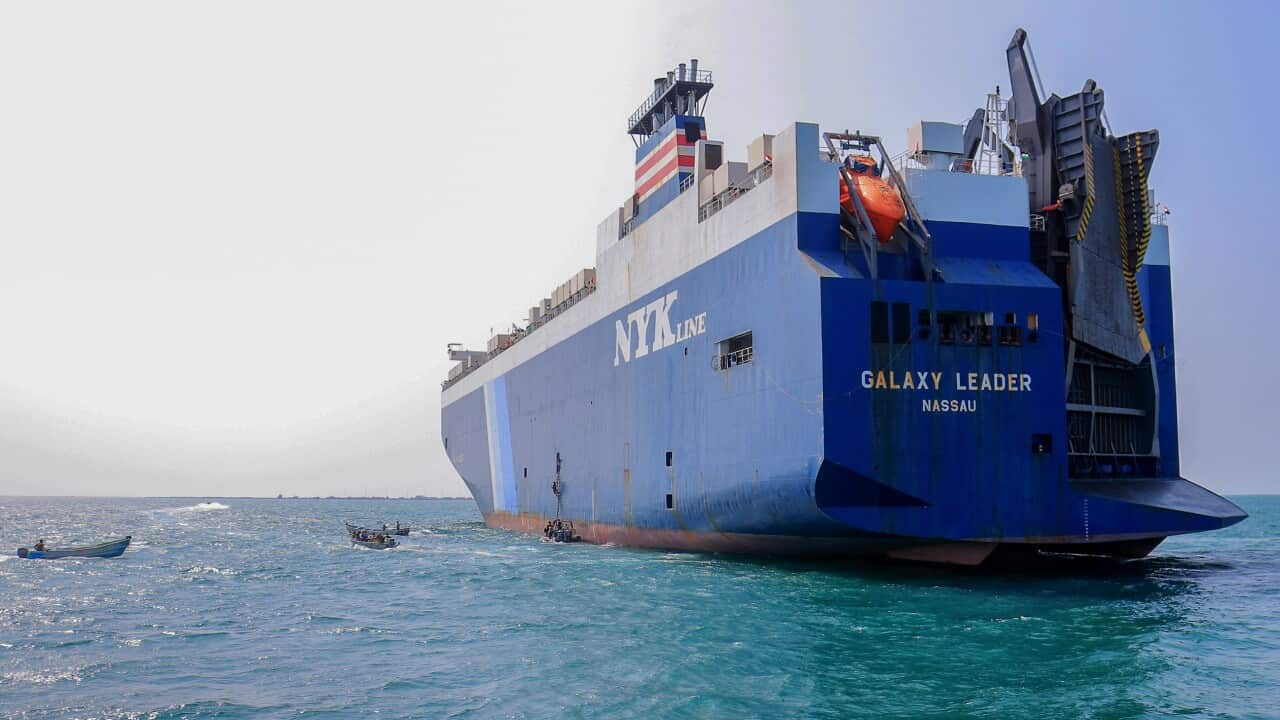Key Points
- Houthi rebels have stepped up attacks on ships in the Red Sea since the start of the Hamas-Israel war.
- The Houthis represent a Shiite movement that have fought against Yemen’s Sunni-majority government for years.
- The US has asked Australia to send a warship to the region to help bolster security and deter more attacks.
Houthi rebels have escalated their attacks on military and commercial ships passing through the Red Sea trade routes since the start of the Hamas-Israel war, after they declared their open support for Palestinians.
By using drones, helicopters, missiles and other weapons, some fired from as far away as Yemen’s capital Sana'a, more than 1,500km away, the group has raised tensions in a region already on edge.
In response, the US, France and other coalition warships have been patrolling the area in a concentrated effort to keep the waterway open and safe.
Here's what you need to know.
What's been happening?
"Houthis have a long history of interfering with merchant shipping to send a strategic message," Jennifer Parker, a naval expert at the ANU's National Security College, told SBS News on Friday.
"They’ve come out and said that they’re effectively trying to blockade the Red Sea for ships transiting to or linked to Israel."
On 31 October, they had fired drones and missiles at Israel, promising to mount attacks until "the Israeli aggression stops."
In November a vehicle transport ship linked to Israel and its 25-member crew taken hostage. The event was widely publicised through a body-camera video of the assault published online.
Ballistic missiles struck three commercial ships in early December, while the USS Carney, a navy destroyer, shot down three drones in the hours-long assault, according to the US military.
Two of the attacks were later claimed by the Houthis, who said they would now target all ships heading to Israel, regardless of nationality, and warned international shipping companies against continuing their trade with Israeli ports.
On 13 December, a Norwegian-flagged tanker off the coast of Yemen was hit by a missile, after it "rejected all warning calls," according to Houthi military spokesperson Brigadier General Yahya Saree.
A French frigate reported shooting down a drone that threatened the same ship during the attack.
US Central Command confirmed on Friday that a ballistic missile was fired from a Houthi-controlled portion of Yemen towards the international shipping lanes in the Red Sea on Thursday.
US navy said it shot down 14 suspected attack drones on Saturday, while the British navy said it downed one drone that was targeting commercial ships, marking one of the latest incidents in the region.
"It is a dramatic escalation," Parker said. "Whether it’s aimed at punishing Israel or whether it's aimed at creating a greater strategic complication in the region, I think the jury is out on that point."
Major trade artery
The Red Sea is an inlet of the Indian Ocean through the Bab el-Mandeb Strait and the Gulf of Aden in the south, which connects to the waters of the Mediterranean Sea through the Suez Canal in the north.
It acts as a crucial maritime highway for ships to bring goods back and forth from Asia to Europe. About 12 per cent of the world's trade passes through the Suez Canal.
Peter Draper is professor and executive director of the Institute for International Trade at the University of Adelaide.
"It’s a really critical trade conduit, and like the Panama Canal, is a key bottleneck," he told SBS News.
"So you really don’t want it to be blocked for any length of time because ships would back up very quickly or have to be rerouted."
What could blocking the Red Sea trade route mean?
In 2021, the Ever Given, a massive container ship operated by Taiwanese transport company Evergreen Marine, became lodged in the Suez Canal for six days, disrupting global trade.
Should the Houthis close the Red Sea to business - a worst-case scenario - Draper said shipping freight rates will go up - inflationary costs that will be passed on to customers. There would also be a rise in insurance costs and even delays in shipments which can have "knock-on effects in terms of various supply chains depending on the mix of commodities".
Draper says the current situation is more of a "nuisance scenario" when it comes to the effects on trade, leading to what he called a "little spike" in insurance rates and possible rerouting of ships, but nothing that will have "systemic impacts".
However, in a swift turnaround since Friday two major freight firms including MSC, the world's biggest container shipping line, said they would avoid the Suez Canal as Houthi militants step up attacks.
Who are the Houthis and how is Iran involved?
The Houthis represent a Shiite movement that has fought a grinding campaign against Yemen’s Sunni-majority government for years. In 2015, a Saudi-led coalition started giving military support to the Yemen government in the ongoing conflict.
Iran and the Islamic Revolutionary Guard Corps have long been accused by the US and the Saudi-led coalition to be backing, training and supplying the Houthis, a claim they downplay or deny.
Iran also backs Hamas, the Palestinian military and political group that has been designated a terrorist organisation by countries including Australia, Canada, the UK and the US.
The 7 October Hamas attack on Israel led to the current Hamas-Israel war. It's a significant escalation in the long-standing conflict between Israel and Hamas.
The Houthis claimed the Yemen capital of Sana'a in 2014 and large areas of the country in 2016, repeatedly targeting Saudi and other forces in the region through drone and missile strikes.

Protestors loyal to the Houthi movement in Sana'a, Yemen, show their support for the decision to target all shipping companies cooperating with Israel or bound for Israeli ports passing through the Arabian and Red Seas. Source: Getty / Mohammed Hamoud
Iran has also become increasingly vocal about its displeasure with the US moving thousands of troops and several warships into the region since the war began.
In response to the US proposition for a naval task force to be established in the Red Sea, the Iranian defence minister Mohammed Reza Ashtiani said, "if they proceed with such an irrational move, they will have to contend with significant problems," in a statement published Thursday by the Iranian ISNA agency. "No one can challenge us in the region where we hold the advantage."
Will Australia get involved?
While Australia is a founding member of the Combined Maritime Force, an entity devoted to the Middle East’s maritime security, it hasn’t deployed a ship to the region since 2020.
A new request by the US for an Australian ship was confirmed by Defence Minister Richard Marles in Darwin on Thursday. He said the government would consider the request, but that priority would be given to Australian interests.

Australia last deployed a Navy ship, the HMAS Toowoomba, to the Middle East in 2020. Source: AP / Van Khoa
However, Parker says despite the scarcity of navy assets and the commitments the country has in the Indo-Pacific, "Australia is already involved."
"When we think about our dependence on maritime trade … saying that we are confined to operating in our region really denies us the ability to protect our own international trade."
With additional reporting from Reuters and AAP



